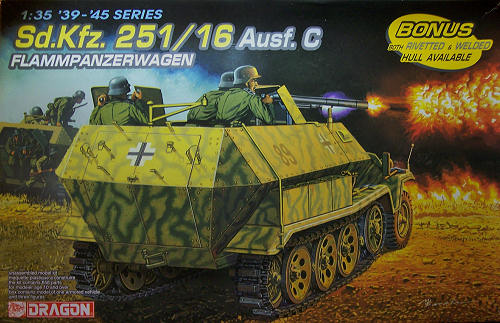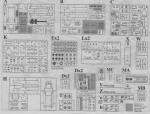Dragon 1/35 Sd.Kfz 151/16 ausf C (Flamm)
|
KIT #: |
6202 |
|
PRICE: |
$49.95 SRP when new
|
|
DECALS: |
|
|
REVIEWER: |
Ray Mehlberger |
|
NOTES: |
|

The Sd.Kfz. 250 and 251 series of German APC half-tracks were both
work-horses of the German forces during WWII. Both series had numerous
variations. This one is the Sd.Kfz. 251/16 Ausf. C Flammpanzerwagen or
Flame-thrower vehicle.
It is thought that the first of these Flammpanzerwagens was introduced in
January of 1943. Two 14mm flame-throwers, behind armoured shields, on each
side of the vehicle and two large tanks in the rear - containing 400 liters
of fuel were installed. The crew was provided with flame retardant
coveralls, but they did not always wear them. The flame-throwers were not
popular with their crews, but they were an effective weapon.
The flame fuel was under 14 atmospheres of pressure. The spray tubes were
attached to a Koebe HL II 40/40 1000/200 pump, which was driven by a 1.1
litre two-stroke DKW-motor with 25hp. The spray tubes attached to both sides
of the fighting compartment could be traversed through an arc of 160
degrees. Their range was 40 meters. A third, hand-held, 7mm flame-thrower
was seen on very early versions of the 251/16. Approximately 347 of these
vehicles were built, mainly by Wumag in Gortitz.
Throughout the war there was always a shortage of the required flame fuel
(jellied petrol). These vehicles were used for the most in Russia, Italy and
Arnhem in 1944. Pictures also show them used in France. There were usually 6
of these vehicles per platoon with 1850 gallons of fuel for them carried
aboard three trucks. This was enough fuel for two refills for the whole
platoon. In addition to the the flame-thrower spray tubes a MG 42 machine
gun with itís shield was carried. The crew consisted of five men: two
flame-thrower operators, a wireless operator, a MG gunner and the driver.
8010 rounds of MG ammo was carried. Flame fuel was sufficient for about 80
short bursts of fire from the spray tubes. These vehicles added much needed
fine-power to the Panzergrenedier units during the last two years of the
war.
 The
kit contains nine cello bags that hold 12 medium gray plastic parts trees,
one cello with a tree of tan colored vinyl figure parts and one cello with a
tree of clear parts.
The
kit contains nine cello bags that hold 12 medium gray plastic parts trees,
one cello with a tree of tan colored vinyl figure parts and one cello with a
tree of clear parts.
A further cello holds: three decal sheets, self-adhesive stickers for the
instrument panel dial faces and a silver stickers for rear-view mirror
faces, three brass PE frets, a length of wire for tow cable, some black
vinyl tubing to put on the flame-throwers when off vehicle, two vinyl
uniform jackets and 2 turned brass fender indicators. All these are fastened
to a stiff cardboard backing. These each have their own cellos too.
This new kit shares some of the same trees as DML's earlier Sd.Kfz. 251/22
Ausf. D (kit no. 6248). These are trees C, D, E and half of tree W (a new
half of this tree has been added to it in this kit). Also, self-adhesing
silver stickers for the rear-view mirrors are the same. Trees A, B, H, L, T
and X are all new. Y and Z (a length of string & some vinyl tubing) are new
also.
The vinyl crew figures and the turned brass width indicator poles, plus the
three brass PE frets are new.
Letter A parts tree holds the welded style hull top, side beams, floor, nose
plate and other panels (26 parts) Ten of these parts are spares or not
needed to complete the model.
Letter B tee holds: hull side panels, rear hull door frame, fire wall,
tools, MG shield etc. (39 parts) Twelve of these parts are spares.
Letter C tree holds: engine access doors, fuel tank halves, MG mounts, two
MGs etc. (54 parts).
There are two identical letter D parts trees. They hold: four x 98K rifles,
the engine compartment lower plate, suspension arms etc. (43 parts per tree)
12 of these parts, per tree, are excess.
There are two identical letter E parts trees. They hold: the road wheels,
idler wheels, drive sprockets, front wheels, some panels and the individual
track links. (78 parts per tree) The track are divided into separate metal
links and the rubber shoes.
It takes 3 parts to make a link. I believe these will be workable when done,
but that will remain to be seen.
There are no letter F and G parts trees, but letter H tree holds all the
parts for doing the riveted body version. (9 parts).
There are also no letter I and J parts trees and two identical letter
L parts trees. These trees hold the parts for the two flame-throwers. (56
parts per tree)
MA and MB are the three brass PE frets for seat back cushion springs, flame
gun shields, weld seams (these are better done with putty), MG ring and
cross-hair sight etc. (13 parts) MC is the two turned brass width indicator
poles. These will have to be bent a little and angled before attachment to
the front fenders. A jig in the kit is provided to do this.
Letter W is the clear parts for vision blocks etc. (16 parts), Letter X is
the single hull tub part while Y and Z are the two different thicknesses of
string.
The vinyl crew figures are designated as small letters a to c. You get two
flame thrower operators and a driver figure. (17 parts) It is said that the
vinyl they are molded in is glueable. The two flame thrower operators come
with alternate asbestos hooded heads.
Finally, is the silver self-adhering stickers for the rear-view mirrors and
two vinyl folded uniform jackets. Stickers are also provided for the
instrument panel guage faces.
The large instruction sheet completes the kit's contents. This sheet
accordion folds out into 10 pages with a total of 21 assembly steps.
On Page 10 are the painting and marking drawings. Although three different
camouflage schemes are shown only one has division markings on it..Grossdeutschland.
You do get one decal sheet with numerous divisional markings (I guess it's
up to you which you want to use), another decal sheet has vehicle numbers
and license plates on it and a third decal sheet provides German national
crosses.
I highly recommend this series of Sd.Kfz. 251 kits. This one is highly
detailed and offers the nice options of either the welded or riveted hull.
There are also two styles of flame tubes to opt from too.
This kit is not for the beginner modeler and is definitely not a weekend
project. Modelers should have a few other kits of this level of parts and
complexity under their belts first. Molding is superb. I found no sinks or
blemishes.
I am apprehensive about the vinyl figures and the two folded uniform
jackets. I found, in the past, that paint does not want to stick to this
soft vinyl stuff and sanding seams on vinyl figures is like trying to sand
jello. I wish these had been molded in hard plastic.
I purchased one kit at my local hobby shop and a second one at a 50% off
sale recently. The kit is generally available at numerous sources.
Ray
MehlbergerJune
2012
If you would like your product reviewed fairly and fairly quickly, please contact the editor
or see other details in the
Note to
Contributors.
Back to the Main Page
Back to the Previews Index Page


 The
kit contains nine cello bags that hold 12 medium gray plastic parts trees,
one cello with a tree of tan colored vinyl figure parts and one cello with a
tree of clear parts.
The
kit contains nine cello bags that hold 12 medium gray plastic parts trees,
one cello with a tree of tan colored vinyl figure parts and one cello with a
tree of clear parts.